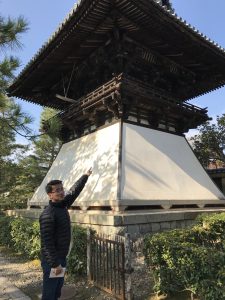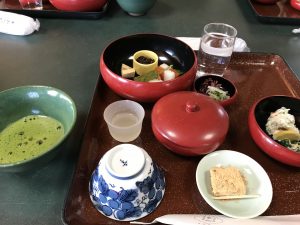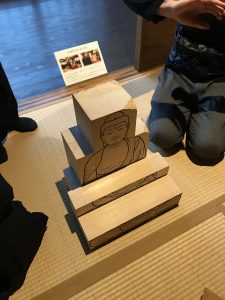Kyoto is continually surpassing my expectations — with every day that passes, I seem to have a new favorite day, though I’m unsure if this is because of the city itself or my tendency to be easily swayed. Even with this looming in my mind, today’s events were engaging and informative, reminding me of why I study art history and why I applied to this program in the first place: to examine temporality in art, specifically in how historical traditions can coexist in a milieu vastly different from the one in which they were created.
I woke up at 7 AM today, marking my gradual adjustment to jet lag. I feel a bit melancholic knowing that my quiet and solitary mornings are fading away, but sorely needed sleep also calls.
We left the hostel at 8:20 to arrive at Terminal Kyoto before 9 for our lecture on all things Zen with Catherine Ludvik. I found her lecture to be our most engaging event thus far, and not simply because her area of expertise was one in which I was interested. She was personable, quick to adjust, and incisive at communicating the artistic manifestations of Zen. We discussed monastic architecture (with focuses on Tofuku-ji and Daitoku-ji), Zen ink scroll paintings, and Buddha statues, which she looked at through both historical and contemporary lenses. I feel that the events we previously attended had focused so strictly upon tradition that her lecture, with its emphasis on means of cultural adaptation, was a breath of fresh air. Her discussion of monastic layouts, with its axes centered around halls of worship, and imagery bore much similarity to what I had learned about Christian monasteries in my Icons seminar last spring — however, the time periods do not overlap whatsoever. After returning to the hostel, I realized it was simply another example of Claude Levi-Strauss’s theory of structuralism at work. The fusion of form and function within these temple structures is also remarkable — case in point, the intricate joinery serves both structural and logistical purposes — it connects both the roof and wall, but also allows for the construction of these parts without a single nail. How fascinating! I had been looking at these interwoven masses at all the temples I had visited, and it was wonderful learning about why they are used.
She discussed how temples are embracing change in a contemporary world, specifically with regards to the screens delineating their rooms. One way is to commission a famous artist (her example was the work of Hiroshi Senji in Daitokuji Jukoin) and another is to seek out young talent (in the form of Yuki Murayabashi, an artist-in-residence at Taizo-in). Both allow for the preservation of tradition through adaptation, which is a form of change that keeps the tradition’s integrity intact. In sum, this lecture left me feeling reinvigorated and earnest to learn more — I’m looking forward to speaking with Professor Ludvik more during our presentation day.
We then took a bus to Daitoku-ji, the temple which we had just learned about minutes ago! It was surreal looking at a photo moments before and then seeing it in the flesh. Though most of the complex was closed because of tea ceremony season, we were still able to see the three main parts–the Sammon Gate, the Buddha Hall, and the Dharma Hall–from afar. Additionally, Leah, Tiffany, and I went to a relaxing Zen rock garden, and I learned more about the deep symbolism of each component.

My natural state: talking about art with no end in sight.
After this, we had dinner at Izusen, a vegetarian restaurant that pleasantly surprised me. They served us multiple courses, and though I am not a big fan of vegetables, I found myself chowing on tempura and even tofu! The best parts were the mochi, yuzu vinegar, and shiitake tempura. It was one of the best meals I’ve had in Kyoto thus far (even better than some of the ramen that I ate).

Our meal.
One extremely crowded bus ride later, we found ourselves back at Terminal Kyoto for a lecture with Gakyu Miyamoto, the Buddha statue sculptor whose works we had encountered in several of the building’s rooms. Since Si Hou and I were tasked with interviewing him, I was both nervous and excited to ask my questions. He was a wonderful and passionate man who incorporated Zen practice and modernity beautifully into his works. He spoke about his unconventional trajectory towards becoming a modern-day busshi, his artistic influences, and his role within today’s society. Furthermore, he gave us more information about the works that are on display, from the flowers he’s carved to the more conventional Buddhas. My favorite work was the hybrid between Kannon and Maria, a veiled figure resting upon a palm, because of its sentimental value–Gakyu had given it to his wife when he proposed to her! I couldn’t help but feel the love required to present such a gesture of affection.

For dinner, we ate at sushi again. While typing up this post, I met this interesting German student who studies in Zurich and was vacationing in Japan. We discussed many things — politics, art, John Berger. It was such a beautiful day today in almost every respect. What will tomorrow bring?

